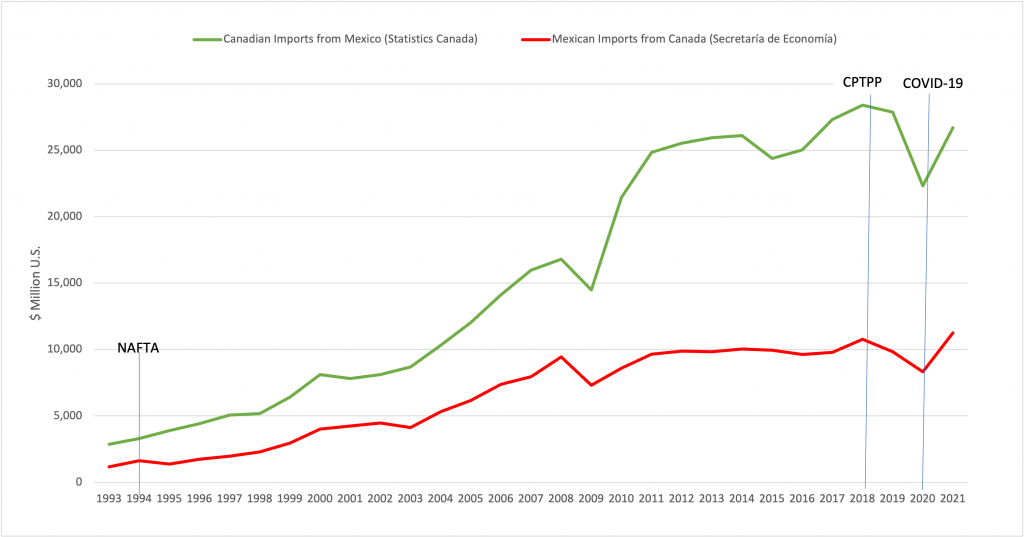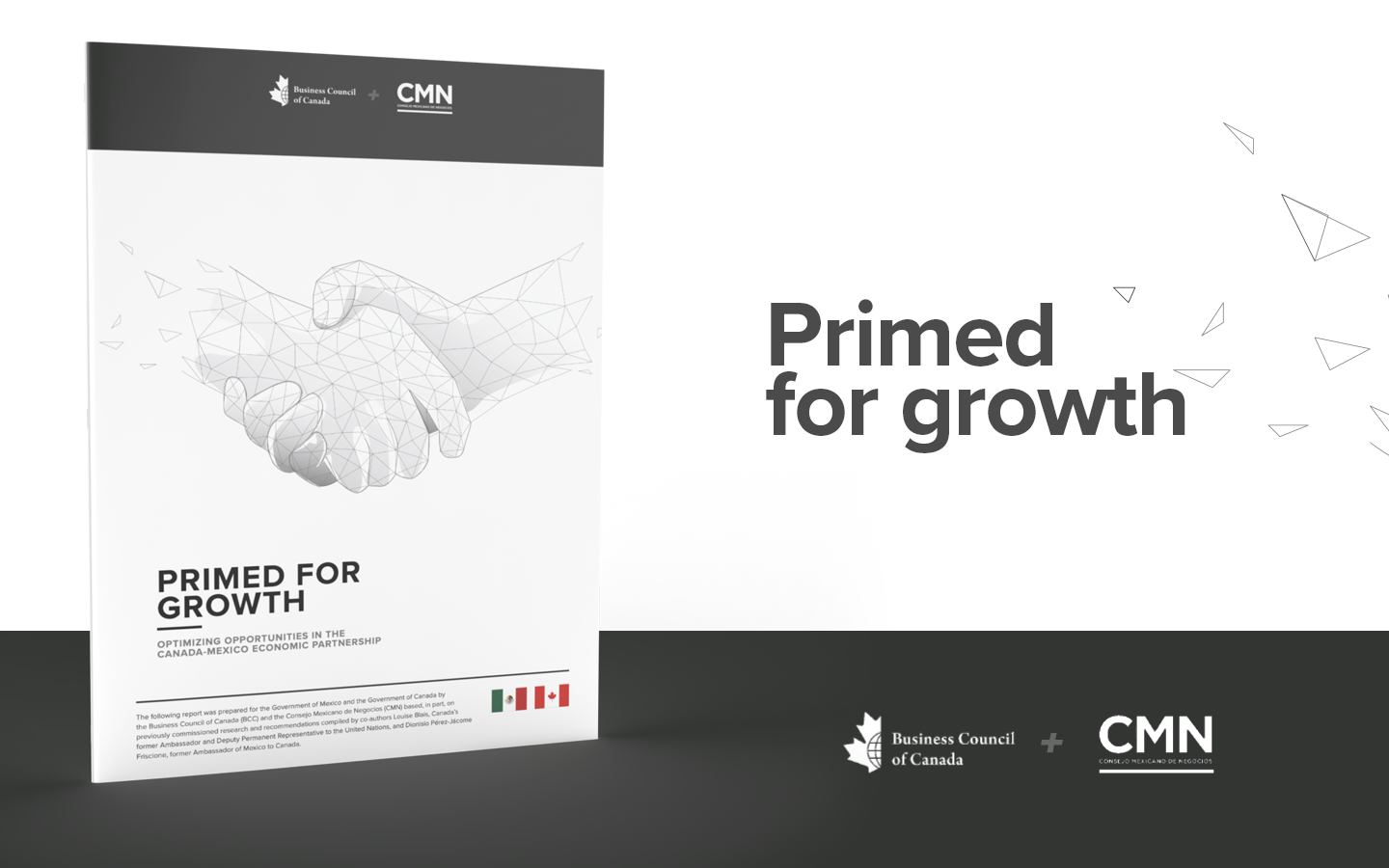Primed for growth
Optimizing opportunities in the Canada-Mexico economic partnership
Introduction
During the inaugural meeting of the Canada-Mexico High-Level Economic Dialogue
(HLED), Mexico’s Secretary of the Economy, Canada’s Minister of International Trade, Export Promotion, Small Business and Economic Development, and Canada’s Minister of Innovation, Science, and Industry asked the BCC and the CMN to produce a joint study which contained actionable recommendations identifying priority sectors for pilot programming and potential partnerships.
The CMN and BCC welcomed the request and, to that end, respectfully submit this report for further consideration at the next meeting of the Canada-Mexico HLED. In summary, the Mexican and Canadian business communities believe it is time for far greater focus on strengthening the bilateral economic relationship between our two countries. Moreover, business leaders believe there is significant unrealized potential and sizable economic opportunities that we can pursue.
In that spirit, and as this report was being prepared, the CMN and BCC have launched a Canada-Mexico Business Summit – an annual forum designed and dedicated to increasing bilateral trade and investment. The Summit will convene business leaders from both countries, serving as the private sector counterpart to the government-to government HLED. The first meeting of the Canada-Mexico Business Summit will take place in Mexico at a date to be determined in Q1 2023.
CUSMA has further demonstrated the importance and potential of the Canada-Mexico bilateral economic partnership – it’s a potential which is yet to be fully seized.
The Canada-Mexico trading relationship
A generation ago, the North American Free Trade Agreement (NAFTA) catalyzed Canada-Mexico trade. Between 1994 and the onset of the COVID-19 pandemic, total Canadian imports from Mexico grew nearly 10-fold from $3.7 billion to $36.9 billion.1 NAFTA not only provided preferential market access through the reduction or elimination of tariffs it also reduced barriers and uncertainty for businesses seeking to enter our respective markets. It was a solid foundation.
Today, NAFTA’s successor, the Canada-United States-Mexico Agreement (CUSMA) builds on that solid foundation by strengthening continental competitiveness and ensuring a high level of predictability for businesses and investors in all three countries. In the first two years since coming into force, CUSMA has further demonstrated the importance and potential of the Canada-Mexico bilateral economic partnership – it’s a potential which is yet to be fully seized.2
As is clear from the chart below, bilateral trade between Canada and Mexico has consistently trended upwards save for two intervening events, the 2008-2009 global recession and the 2020 global pandemic. The resilience and robustness of the economic partnership is evidenced by the fact that trade rebounded quickly and significantly in the years since those two events. This proves that the strength of the underlying fundamentals of the economic partnership are strong.
Figure 1: Mexico-Canada Trade 1993-2021 ($ million u.s.)

Given the highly integrated nature of the North American continental economy, we must consider our common neighbour, the United States. The U.S. is the number one trading partner for both Canada and Mexico, accounting for more than 75% of each countries’ international trade. Not only is the current trading relationship between Canada and Mexico underdeveloped in comparison to their respective trade with the United States it also lacks the same diversity.
Canada-Mexico trade is largely dominated by the automotive sector, which accounts for 35% of all Canadian imports from Mexico ($12 billion annually). Canada’s exports to Mexico are somewhat more diversified, spanning agri-food, motor vehicles, and consumer goods, but the total value is significantly lower than the value of Mexico’s exports to Canada. Fortunately, there are significant complementarities between the two economies which are ready to be seized.
More specifically, Mexico has a far higher working age population with more than 38.8 million citizens aged 20-40 – which is greater than the entire population of Canada. Mexican workers have proven invaluable to the Canadian economy as skilled immigrants, temporary foreign workers, and seasonal agricultural workers. Where Canada is currently dealing with a growing labour shortage, increased cross border workforce mobility could have an immediate impact.
Canada, in turn, has considerable expertise in areas where there is growing Mexican demand including aerospace, financial services, green technology, and energy infrastructure. To cite one example, it was recently announced that TC Energy would build a $4.5 billion Southeast Gateway Pipeline – a vital energy infrastructure project to transport natural gas. Further investments in export-enabling infrastructure are desperately needed in both our countries.
Moreover, the Mexican and Canadian governments have rightly prioritized efforts to ensure greater participation in our integrated continental economy from women, Indigenous peoples, and other underrepresented groups. For bilateral economic growth to be inclusive, sustainable, equitable, and diverse, it is essential that our respective public and private sectors identify innovative and imaginative ways to harness and leverage the full potential of all our peoples.
Recommendations
Recommendation 1: Promote bilateral investment in priority sectors
Mexico and Canada should promote and prioritize bilateral trade and investment in key innovation sectors including agri-tech, clean-tech, med-tech, and advanced manufacturing, including through government-led trade missions. In addition, investment in trade-enabling infrastructure – energy export infrastructure, expanded seaport capacity, and modernized land border crossings for road and rail – would improve supply chain resilience, facilitate increased nearshoring, and strengthen commercial ties between our two countries and higher competitiveness for our shared continent. An agreement among securities regulators and exchanges could also help companies access capital markets in each country.
Recommendation 2: Streamline cross-border workforce mobility
Canada and Mexico should work together to expedite the approval of temporary work permits and ensure the recognition of workforce credentials/certifications in priority sectors by relevant professional and regulatory bodies. Streamlined workforce mobility between Mexico and Canada would increase continental competitiveness as well as strengthen bilateral economic ties. Among the priority sectors experiencing urgent need for skilled labour, and identified in Canada’s expanded Temporary Foreign Worker Program, are agriculture, health care, forestry, construction, hospitality, fisheries, as well as mining.
Recommendation 3: Develop a joint strategy to bolster the competitiveness of our manufacturing sectors
A joint strategy would focus on identifying shared Mexican and Canadian interests relating to trade and investment policies, with a special emphasis on manufacturing and innovation that support the green energy transition. A key objective of this work will be to ensure that such policies strengthen North American competitiveness. The strategy could be a permanent workstream of the Canada-Mexico High-Level Economic Dialogue.
Recommendation 4: Prioritize greater engagement between Mexican states and Canadian provinces
The Canada-Mexico bilateral relationship is almost always discussed as being between two entities. Given that significant economic development activity falls within the jurisdiction of Mexico’s 32 states and Canada’s 10 provinces and 3 territories, efforts should be made to promote greater engagement between and among those governments. One such effort could be to establish an annual conference modeled on the SEUS-CP (Alliance of Southeastern US States and Eastern Canadian Provinces) gathering which brings together U.S. states and Canadian provinces to identify trade and investment opportunities at the sub-federal level.
Recommendation 5: Increase collaboration between the public and private sectors to safeguard integrated infrastructure from cyber attacks and other threats
Mexico and Canada must work together to enhance the resilience of our integrated supply chain, transportation, and energy infrastructure in the face of increasing and evolving cyber attacks and other threats. Increased information and intelligence sharing between governments with businesses would better protect critical infrastructure from those who want to disrupt or disable key cross-border networks. Canada and Mexico could also consider creating a High-Level Security Dialogue to complement our newly established bilateral High-Level Economic Dialogue (HLED).
Recommendation 6: Explore the establishment of a bilateral virtual centre of excellence for women and minority-led businesses
Both Canada and Mexico are committed to expanding opportunities for women, minority and Indigenous entrepreneurs and business leaders. A bilateral virtual Centre of Excellence could provide information to underrepresented groups on such things as market development and export/import regulations and supply-chain management. It could also offer training on accessing investment capital, developing supplier diversity programs, and securing government assistance. Potential models for such an initiative include UPS Canada’s Women Exporters Program and CMN’s Mexican Center for Competitiveness. Like those two programs, the Centre of Excellence could perform a valuable service by facilitating business-to-business networking and mentoring opportunities.
Footnotes
-
1. Global Affairs Canada. The Canada-United States-Mexico Agreement: Economic Impact Assessment. 2020.
2. In addition to CUSMA, Canada and Mexico are both parties to the Comprehensive and Progressive Agreement for Trans-Pacific Partnership (CPTPP) which offers additional opportunities for investors and exporters.












